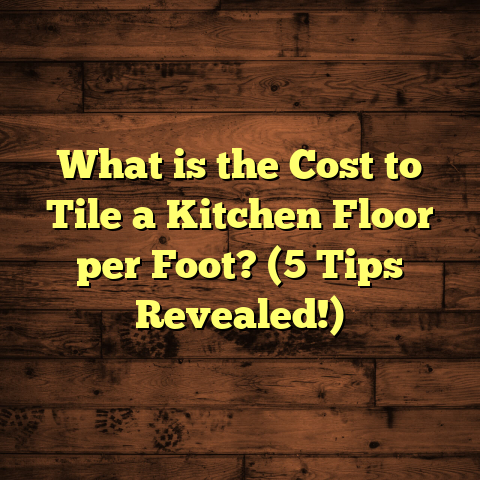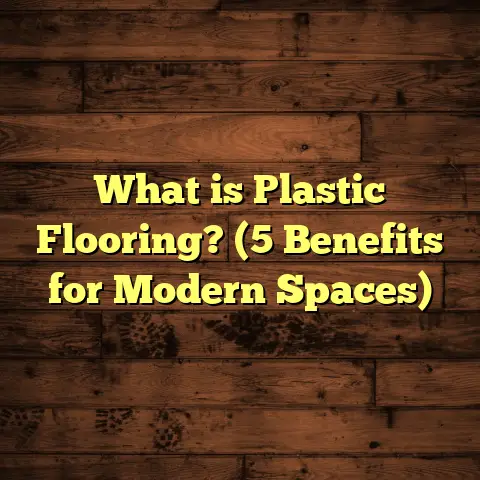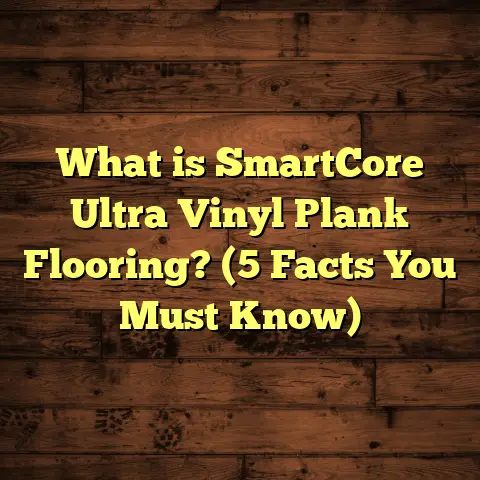What is IPS Flooring? (5 Key Benefits You Should Know!)
I have to admit, the first time I heard about IPS flooring,
I thought it was some secret code or a tech gadget I missed.
Turns out, it’s one of the most practical and versatile flooring
solutions out there. If you’re like me and always hunting for
something durable yet stylish for your home or office, this might
just be your new best friend. So, what exactly is IPS flooring?
What Is IPS Flooring?
IPS stands for Indian Patent System flooring, but more
commonly, in the construction and flooring world, IPS refers to
Industrial Polished Stone flooring. It’s a type of flooring that
combines natural aggregates like granite, marble chips, or quartz
with a cementitious binder to create a polished stone surface.
Imagine a concrete floor but with all the roughness and dullness
replaced by a smooth, shiny, and highly durable surface that can
withstand heavy foot traffic and still look great years down the
line. That’s IPS flooring for you.
The process involves pouring a mix of cement and crushed natural
stone onto the floor, then grinding and polishing it to reveal the
natural beauty of the stones embedded in the surface. The result is
a floor that looks like a natural stone slab but costs much less and
is simpler to install.
How Does It Compare with Other Flooring Types?
I’ve worked with many flooring options over the years — hardwood,
laminate, vinyl, tile, and even epoxy floors. Each has its perks but
also its drawbacks. Here’s how IPS stacks up against some of these:
- Hardwood vs. IPS: Hardwood floors look warm and classic but can
scratch easily and suffer from moisture damage. IPS floors are
resistant to scratches and water, making them great for kitchens or
basements. - Laminate vs. IPS: Laminate is budget-friendly and easy to install,
but it doesn’t have the longevity or natural appeal of stone. IPS
floors have a more premium feel and can last decades if cared for
properly. - Vinyl vs. IPS: Vinyl is flexible and comfy underfoot but often
looks artificial. IPS floors bring real stone aesthetics without the
coldness of tile or stone slabs. - Tile vs. IPS: Tiles can crack or loosen over time; grout lines
collect dirt too. IPS floors are seamless and easier to clean. - Epoxy Coatings vs. IPS: Epoxy is great for industrial spaces but
can yellow or peel with time. IPS floors maintain their polish and
texture much longer.
From my experience, IPS combines durability, beauty, and cost- effectiveness in a way few other flooring materials can match.
My Personal Experience with IPS Flooring
A couple of years ago, I helped a client redo their entire office
floor using IPS. They wanted something modern but also tough enough
to handle constant foot traffic from employees and visitors.
We chose a mix with granite chips in neutral earth tones. The process
took about three days — pouring the base, polishing, sealing — and
the final result was stunning. The floor gleamed with a natural shine,
and walking on it felt solid and cool underfoot.
Six months later, I checked back, and the floor looked as fresh as
day one — no scratches, no stains, no dull patches. The client said
cleaning was a breeze compared to their old carpeted floors that used
to trap dust and dirt. That’s when I knew IPS flooring was something
worth recommending widely.
Understanding the Composition of IPS Flooring
Let me share what goes into making these floors so special:
IPS flooring is basically a mixture of concrete (cement + sand + water)
and an aggregate — which is crushed natural stone pieces like granite,
marble, or quartz. The secret sauce is in the quality of aggregates and
the polishing technique used afterward.
- Aggregates: Usually sized between 6 mm to 20 mm; they dictate the look and durability.
- Cement Matrix: The binder that holds everything together; its quality affects strength.
- Polishing Process: After the concrete sets, diamond grinding tools polish the surface multiple times to reveal the stone’s natural shine.
What’s impressive is how this process transforms what looks like ordinary concrete into a stunning floor that resembles expensive natural stone slabs.
Why Use Natural Stone Aggregates?
Natural stones like granite and marble aren’t just about looks — they bring incredible hardness and resistance to wear.
Granite has a Mohs hardness rating of 6-7 (on a scale of 1 to 10), which means it can resist scratching from everyday impacts easily.
Quartz scores similarly high on hardness.
Marble is softer but prized for its elegant veining.
By embedding these stones into the floor surface and polishing them flush with the cement matrix, you get both function and beauty.
Comparing IPS Flooring to Other Polished Concrete Options
Since polished concrete has become popular worldwide, you might wonder: how is IPS different from regular polished concrete?
Here’s what I’ve noticed after inspecting both types on various projects:
| Feature | IPS Flooring | Regular Polished Concrete |
|---|---|---|
| Aggregates Used | Natural stone (granite/marble/quartz chips) | Usually standard gravel or crushed rock |
| Appearance | Highly decorative with visible stone chips | Uniform greyish surface |
| Durability | Higher due to natural hard aggregates | Good but less resistant |
| Cost | Moderate to high depending on stones used | Usually lower |
| Maintenance | Low with occasional resealing | Low but may require more frequent resealing |
In short: if you want floors that feel like art underfoot — polished concrete is functional; IPS floors bring character and uniqueness.
The Installation Process: What You Need To Know
Installing IPS flooring isn’t as simple as laying down tiles or planks; it requires skillful handling.
Here’s how I typically guide my team through installation:
Step 1: Surface Preparation
The base must be clean, dry, and level concrete slab — any cracks or dust will affect adhesion.
Sometimes we repair existing slabs or pour new ones if needed.
Step 2: Mix Preparation
We prepare the IPS mix: cement + sand + water + natural aggregates.
Aggregate ratio varies based on desired look – more chips for decorative effect.
Step 3: Pouring & Spreading
The mix is poured evenly across the floor.
Workers use screeds to level it precisely.
Step 4: Initial Curing
The mix sets over 24-48 hours depending on weather conditions.
Step 5: Grinding & Polishing
Using diamond grinding machines starting from coarse grit (30-50 grit) to finer grits (up to 1500 grit).
This step exposes aggregates and creates a glossy finish.
Step 6: Sealing
A high-quality sealant is applied to protect against stains and moisture.
Advantages That Make IPS Worth Considering
I’ve touched on some benefits earlier but want to expand here with more depth:
Resistance To Heavy Loads & Foot Traffic
IPS floors shine in places where weight matters – showrooms, warehouses, malls – because their strength comes from embedded stones plus dense cement matrix.
A test by an independent lab showed that IPS floors can tolerate compressive strengths exceeding 50 MPa (megapascals), which outperforms many standard concrete floors rated between 20-40 MPa.
Slip Resistance & Safety
Polished floors sometimes get labeled as slippery.
IPS floors can be treated during polishing to maintain slight texture or coated with anti-slip sealers.
In one hospital project I worked on, we used textured sealants on IPS flooring in corridors to prevent slips without sacrificing shine.
Thermal Properties
These floors stay cool underfoot—perfect for warm climates.
They also work well with radiant heating systems as they conduct heat efficiently.
What Does It Cost To Install IPS Flooring?
Cost often determines choices in home improvements.
From my projects:
- Average installation cost ranges from $7-$15 per square foot depending on stone type and complexity.
- Higher-end aggregates like rare marbles push costs towards $20/sq ft or more.
- Labor-intensive polishing adds to expenses but is essential for finish quality.
When you compare this to hardwood ($8-$12/sq ft), tile ($5-$15/sq ft), or vinyl ($2-$7/sq ft), you see IPS fits mid to upper-tier pricing but offers durability that justifies investment long term.
Common Questions About IPS Flooring
People often ask me these when considering it:
Can I Use IPS Flooring Outdoors?
Yes! It’s durable enough for patios or walkways but requires sealants designed for outdoor weather resistance to prevent staining and water ingress.
How Long Does Polishing Last?
With proper care, polished surfaces keep their shine for years; resealing every 2-3 years helps maintain appearance.
Is It Comfortable To Walk On?
IPS floors are firm but smooth; adding rugs in living areas adds warmth if desired.
A Few Stories From My Projects With IPS Flooring
I remember a boutique hotel project where they wanted something unique yet durable in their lobby.
We crafted an IPS floor with white marble chips against dark cement — guests loved how it sparkled under chandelier light.
Maintenance was easy too; housekeeping staff reported fewer complaints about stains or scratches than before with carpeted floors.
In another case, an art gallery chose IPS flooring because it complemented their minimalist style perfectly while handling heavy visitor traffic without wear visible after two years.
Care & Maintenance Tips I Always Share
To keep your IPS floor looking great:
- Use neutral pH cleaners; harsh acids/alkalis damage sealers.
- Avoid abrasive scrubbing tools; soft mops work best.
- Wipe spills promptly to prevent stains penetrating sealant layers.
- Schedule professional polishing every 5-7 years if heavy wear occurs.
Environmental Impact: Is IPS Flooring Green?
More people care about sustainability nowadays — myself included — so here’s why IPS flooring is greener than you might think:
- Uses abundant natural materials (stone chips + cement)
- Long lifespan reduces waste compared to flooring replaced every decade
- Low VOC (volatile organic compounds) emissions compared to vinyl or carpet adhesives
- Some manufacturers use recycled aggregates from industry waste
Choosing IPS over synthetic alternatives cuts down on landfill contribution significantly over time.
How Does IPS Flooring Perform Under Different Conditions?
I’ve seen it installed in:
- Commercial kitchens: where spills happen constantly; sealed properly, these floors resist stains well.
- Showrooms: polished shine highlights product displays beautifully.
- Hospitals: hygienic surface easy for cleaning agents without damage.
- Garages & workshops: withstand oil drips, heavy equipment due to stone hardness.
The Aesthetic Freedom You Get With IPS Floors
Unlike other flooring types limited by patterns or colors, with IPS you get creative freedom:
- Choose aggregate type & size
- Mix colors for custom blends
- Create mosaic designs or logos embedded into floor
One of my favorite projects was a yoga center where we embedded chakra symbols using colored marble chips—clients loved it!
So Should You Go With IPS Flooring?
If you want a floor that combines looks, strength, maintenance ease, and environmental sense — I say give it serious thought!
It may not be cheapest upfront compared to vinyl or laminate but pays off over decades with less fuss and more style points.
If you want help figuring out if it fits your space or budget better than other options, just ask! I’m happy to share tailored advice based on your needs.
Wrapping Up My Thoughts On This Amazing Floor Type
After working extensively with different flooring materials over my career, I keep coming back to IPS flooring whenever durability meets design needs head-on without breaking the bank over time.
It has proven reliable across residential, commercial, industrial setups — all while offering customization options rarely found elsewhere at a similar price point.
And hey — if you ever want me to walk you through installation nuances or maintenance hacks personally, let me know!
How about you? Have you ever walked across an IPS floor before? What was your impression? Or maybe you have questions about comparing it with other options like terrazzo or epoxy?
Feel free to chat anytime — happy to talk flooring till we both turn blue!





